|
|
|
Sort Order |
|
|
|
Items / Page
|
|
|
|
|
|
|
| Srl | Item |
| 1 |
ID:
183918
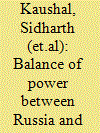

|
|
|
|
|
| Publication |
Abingdon, RUSI for Defence and Security Studies, 2022.
|
| Description |
v, 105p.pbk
|
| Series |
Whitehall Paper; 100
|
| Standard Number |
9781032309651
|
|
|
|
|
|
|
|
|
|
|
|
Copies: C:1/I:0,R:0,Q:0
Circulation
| Accession# | Call# | Current Location | Status | Policy | Location |
| 060161 | 355.005/KAU 060161 | Main | On Shelf | General | |
|
|
|
|
| 2 |
ID:
123485
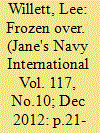

|
|
|
| 3 |
ID:
106794
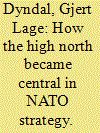

|
|
|
|
|
| Publication |
2011.
|
| Summary/Abstract |
From the late 1970s and until the end of the Cold War, the 'High North' constituted a central theatre for military forces. Extensive NATO preparations were made, a solid infrastructure developed in northern Norway, and frequent and large-scale exercises were carried out. These developments, from the late 1970s, were much discussed by scholars and strategists. However, the change of perception, laying the foundation for the military build-up, had actually occurred a decade earlier, in the late 1960s. This change has not yet been given its rightful attention, partly because the relevant documents have only recently become available. This essay takes the chronology of events back into the 1960s and to NATO's secret discussions between the national Ministers of Defence and Chiefs of Staff. The most significant turning-points were the Flexible Response strategy of 1967; SACLANT's concern over increased Soviet naval activity and his 'Maritime Strategy' studies of 1965 and 1967; NATO's awakening to the Soviet SSBN threat in 1967; and the concept of 'External Reinforcement of the Flanks' of 1968 - finally followed by the 'Brosio Study' (named after the then NATO Secretary-General) of 1969. As a consequence of these developments NATO's 'tactical northern flank' was set to become an independent strategic theatre.
|
|
|
|
|
|
|
|
|
|
|
|
|
|
|
|
| 4 |
ID:
136072
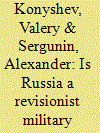

|
|
|
|
|
| Summary/Abstract |
In contrast with a widespread perception of Russia as an expansionist power in the Arctic, this article argues that Moscow does not seek military superiority in the region. Rather, Moscow's military strategies in the Arctic pursue three major goals: first, to demonstrate and ascertain Russia's sovereignty over its exclusive economic zone and continental shelf in the region; second, to protect its economic interests in the High North; and third, to demonstrate that Russia retains its great power status and still has world-class military capabilities. The Russian military modernization programs are quite modest and aim at upgrading the Russian armed forces in the High North rather than providing them with additional offensive capabilities or provoking a regional arms race. The Russian ambitions in the Arctic may be high, but they are not necessarily implying the intentions and proper capabilities to confront other regional players by military means. On the contrary, Moscow opts for soft rather than hard power strategy in the Arctic.
|
|
|
|
|
|
|
|
|
|
|
|
|
|
|
|
| 5 |
ID:
188489
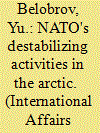

|
|
|
|
|
| Summary/Abstract |
AFTER nearly three decades of constructive cooperation in the Arctic between Russia and NATO member states, the region is returning to the era of tough confrontation. NATO's leading countries have a growing irrepressible desire to dominate the entire Arctic as increasingly rapid ice melt in the region caused by global climate change makes its seas more navigable and opens new opportunities for tapping its rich natural resources. In pursuit of this goal, NATO countries are ramping up their military activity and offensive potential, creating a major threat to Russian interests in the region, the lion's share of which is under Russian sovereignty, as even Western experts acknowledge.
|
|
|
|
|
|
|
|
|
|
|
|
|
|
|
|
| 6 |
ID:
139600
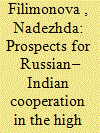

|
|
|
|
|
| Summary/Abstract |
The paper examines emerging prospects for Russia–India cooperation. While the two countries can collaborate in various areas of mutual interest, the paper identifies possible challenges and effects on the cooperation in the Arctic region. The sanctions imposed by the West could impede Russian energy projects in the Arctic. This could force the state to find a way to replace Western technologies through enhancing capacities of national industry and developing cooperation with other states, including Asian countries. This shift is also bolstered by the political interest to strengthen the position of Russia in the Asian region as a whole, and to increase the country's energy security. The paper provides an overview of the Russian and Indian interest and policy in the Arctic, and presents the perspectives and challenges for both countries.
|
|
|
|
|
|
|
|
|
|
|
|
|
|
|
|
| 7 |
ID:
185914
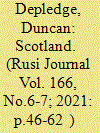

|
|
|
|
|
| Summary/Abstract |
Scotland’s geostrategic significance to the High North is being overlooked in debates about the potential impacts of ‘Scexit’, as well as wider discussions about the changing Arctic security environment. Duncan Depledge and Andreas Østhagen address this oversight by drawing attention to Scotland’s historic role in contributing to the defence of NATO’s ‘northern flank’ and analysing how this is being resurrected in response to new challenges emerging in the High North. They conclude that there are some specific challenges that policymakers should address as the independence debate continues: most importantly, the potential for a ‘gap’ to be created in the regional security architecture of the High North.
|
|
|
|
|
|
|
|
|
|
|
|
|
|
|
|
| 8 |
ID:
096785
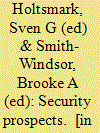

|
|
|
|
|
| Publication |
Rome, NATO Defence College, 2009.
|
| Description |
199p.
|
|
|
|
|
|
|
|
|
|
|
|
Copies: C:1/I:0,R:0,Q:0
Circulation
| Accession# | Call# | Current Location | Status | Policy | Location |
| 055014 | 355.03/HOL 055014 | Main | On Shelf | General | |
|
|
|
|
| 9 |
ID:
119231
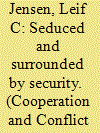

|
|
|
|
|
| Publication |
2013.
|
| Summary/Abstract |
Combining elements of the Copenhagen school's securitization theory with a Foucauldian discourse analysis, this article examines certain discursive processes that emerged in the wake of Norway's 2005 High North Initiative. The Norwegian government's explicit politicization of energy issues appears to have acted as door opener, letting 'security' in to colonize the High North discourses once more. Russia is again firmly positioned as the 'radical other', leaving the discursive field open to various forms of securitizing discourses. The post-2005 discursive field of the Northern areas is, in many ways, more open-ended, complex and confusing than ever. The opening up and expansion of the concept of High North security means that 'everything' is seen as having a security potential. What does seem clear is the increasing presence of security in primary texts and the media debate: entry to and credibility in the discourse depends on 'security speak' across an ever-widening array of thematic contexts. The article also argues that a combination of securitization theory and discourse analysis seems a fruitful way forward in shifting more focus towards the active and important role of the audience in securitizing processes.
|
|
|
|
|
|
|
|
|
|
|
|
|
|
|
|
| 10 |
ID:
189388
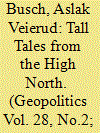

|
|
|
|
|
| Summary/Abstract |
The Arctic region is rapidly changing amidst accelerating climate change. This has led to a striking international consensus on the importance of safeguarding its environment and keeping the region conflict-free. Despite this face-value consensus, discussions on Arctic politics are often framed in competitive and contentious terms. Why do actors with seemingly common goals clash in heated debates? This article seeks to explain this discord by analysing whether actors have a shared understanding of what the region is and thus what they are trying to manage and safeguard. This article reveals, through discourse analysis of a large range of actor’s descriptive documents on the Arctic, that environmental issues predominate discourses of the Arctic, but that this consensus is undermined by diverging conceptions about what these environmental changes entail. Disagreements on the nature of the Arctic as a zone with economic potential or geostrategic relevance reveal that there is contestation in how actors conceive of the region. These contested discourses have already left their mark on Arctic cooperation structures, and need to be considered in both current and future efforts to manage the region.
|
|
|
|
|
|
|
|
|
|
|
|
|
|
|
|
|
|
|
|
|